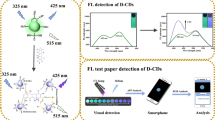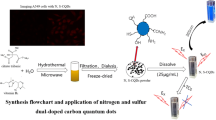Abstract
A label-free fluorescence sensor based on near-infrared carbon dots (NIR-CDs) and aptamer is described for the highly sensitive and selective detection of ciprofloxacin (CIP). NIR-CDs were synthesized from polyethyleneimine and reduced glutathione by one-step hydrothermal method. The electrostatic interaction between the positively charged carbon dots and the negatively charged aptamer resulted in fluorescence quenching. After the addition of CIP, the specific binding between CIP aptamer and CIP was stronger, resulting in fluorescence recovery. Under the optimal experimental conditions, the recovered fluorescence intensity has a linear relationship with the concentration of CIP in the range 0.5–800 ng/mL, and the detection limit is 0.167 ng/mL. The prepared carbon dots have excellent optical properties and biocompatibility, and due to their emission characteristics in the near-infrared window, they can be used for biological imaging, which has also been confirmed in the experiment. The feasibility of the label-free fluorescence sensor for the detection of CIP is also proved by confocal fluorescence imaging. The detection results of CIP determination in milk by this sensor are satisfactory, indicating that the developed sensor has great application potential.
Graphical abstract








Similar content being viewed by others
References
Aldred KJ, McPherson SA, Turnbough CL Jr, Kerns RJ, Osheroff N (2013) Topoisomerase IV-quinolone interactions are mediated through a water-metal ion bridge: mechanistic basis of quinolone resistance. Nucleic Acids Res 41:4628–4639. https://doi.org/10.1093/nar/gkt124
Ionescu RE, Jaffrezic-Renault N, Bouffier L, Gondran C, Cosnier S, Pinacho DG, Marco MP, Sanchez-Baeza FJ, Healy T, Martelet C (2007) Impedimetric immunosensor for the specific label free detection of ciprofloxacin antibiotic. Biosens Bioelectron 23:549–555. https://doi.org/10.1016/j.bios.2007.07.014
Yu W, Zhan S, Shen Z, Zhou Q, Yang D (2017) Efficient removal mechanism for antibiotic resistance genes from aquatic environments by graphene oxide nanosheet. Chem Eng J 313:836–846. https://doi.org/10.1016/j.cej.2016.10.107
Zhang R, Wang Y, Yu L-P (2014) Specific and ultrasensitive ciprofloxacin detection by responsive photonic crystal sensor. J Hazard Mater 280:46–54. https://doi.org/10.1016/j.jhazmat.2014.07.032
Castilla-Fernandez D, Moreno-Gonzalez D, Beneito-Cambra M, Molina-Diaz A (2019) Critical assessment of two sample treatment methods for multiresidue determination of veterinary drugs in milk by UHPLC-MS/MS. Anal Bioanal Chem 411:1433–1442. https://doi.org/10.1007/s00216-019-01582-y
Tian H, Liu T, You S, Zhang F (2020) Rapid determination of trace ciprofloxacin residue in milk samples using molecularly imprinted membrane extraction-high performance liquid chromatography-tandem mass spectrometry. Chin J Chromatogr 38:775–781. https://doi.org/10.3724/sp.J.1123.2020.02017
Zan G, Wu T, Zhu F, He P, Cheng Y, Chai S, Wang Y, Huang X, Zhang W, Wan Y, Peng X, Wu Q (2021) A biomimetic conductive super-foldablematerial. Matter 4:3232–3247. https://doi.org/10.1016/j.matt.2021.07.021
Heidarian SMT, Sani AT, Danesh M, Ramezani M, Alibolandi M, Gerayelou G, Abnous K, Taghdisi SM (2021) A novel electrochemical approach for the ultrasensitive detection of fluoroquinolones based on a double-labelled aptamer to surpass complementary strands of aptamer lying flat. Sens. Actuators B Chem. 334. https://doi.org/10.1016/j.snb.2021.129632
Sabeti M, Ensafi AA, Mousaabadi KZ, Rezaei B (2021) A selective electrochemical sensor based on a modified-glassy carbon electrode using f-MWCNTs-polydopamine for ciprofloxacin detection. IEEE Sens J 21:19714–19721. https://doi.org/10.1109/jsen.2021.3100251
Wang X, Li Y, Li R, Yang H, Zhou B, Wang X, Xie Y (2019) Comparison of chlorination behaviors between norfloxacin and ofloxacin: reaction kinetics, oxidation products and reaction pathways. Chemosphere 215:124–132. https://doi.org/10.1016/j.chemosphere.2018.09.100
Wang S, Chen H, Xie H, Wei L, Xu L, Zhang L, Lan W, Zhou C, She Y, Fu H (2021) A novel thioctic acid-carbon dots fluorescence sensor for the detection of Hg2+ and thiophanate methyl via S-Hg affinity. Food Chem 346. https://doi.org/10.1016/j.foodchem.2020.128923
Xue J, Yi J, Zhou H (2021) Label-free fluorescence molecular beacon probes based on G-Triplex DNA and thioflavin T for protein detection. Molecules 26. https://doi.org/10.3390/molecules26102962
Chai S, Zan G, Dong K, Wu T, Wu Q (2021) Approaching superfoldable thickness-limit carbon nanofiber membranes transformed from water-soluble PVA. Nano Lett 21:8831–8838. https://doi.org/10.1021/acs.nanolett.1c03241
Dang VD, Ganganboina AB, Doong R-A (2020) Bipyridine- and copper-functionalized N-doped carbon dots for fluorescence turn off-on detection of ciprofloxacin. ACS Appl Mater Interfaces 12:32247–32258. https://doi.org/10.1021/acsami.0c04645
HuaJ, Jiao Y, Wang M, Yang Y (2018) Determination of norfloxacin or ciprofloxacin by carbon dots fluorescence enhancement using magnetic nanoparticles as adsorbent. Microchim Acta 185.https://doi.org/10.1007/s00604-018-2685-x
Gao W, Song H, Wang X, Liu X, Pang X, Zhou Y, Gao B, Peng X (2018) Carbon dots with red emission for sensing of Pt2+, Au3+, and Pd2+ and their bioapplications in vitro and in vivo. ACS Appl Mater Interfaces 10:1147–1154. https://doi.org/10.1021/acsami.7b16991
Liu ML, Chen BB, Li CM, Huang CZ (2019) Carbon dots: synthesis, formation mechanism, fluorescence origin and sensing applications. Green Chem 21:449–471. https://doi.org/10.1039/c8gc02736f
A. Nguyen Thi Ngoc, A. D. Chowdhury, R.-A.Doong, (2017) Highly sensitive and selective detection of mercury ions using N, S-codoped graphene quantum dots and its paper strip based sensing application in wastewater. Sens Actuators B Chem 252:1169–1178. https://doi.org/10.1016/j.snb.2017.07.177
Atchudan R, Edison TNJI, Perumal S, Selvam NCS, Lee YR (2019) Green synthesized multiple fluorescent nitrogen-doped carbon quantum dots as an efficient label-free optical nanoprobe for in vivo live-cell imaging. J Photoch Photobio A 372:99–107. https://doi.org/10.1016/j.jphotochem.2018.12.011
Zong J, Yang X, Trinchi A, Hardin S, Cole I, Zhu Y, Li C, Muster T, Wei G (2014) Carbon dots as fluorescent probes for “off-on” detection of Cu2+ and L-cysteine in aqueous solution. Biosens Bioelectron 51:330–335. https://doi.org/10.1016/j.bios.2013.07.042
Zan G, Wu T, Dong W, Zhou J, Tu T, Xu R, Chen Y, Wang Y, Wu Q (2022) Two-level biomimetic designs enable intelligent stress dispersion for super-foldable C/NiS nanofiber free-standing electrode. Adv Fiber Mater. https://doi.org/10.1007/s42765-022-00162-7
Yang T, Tang YA, Liu L, Lv X, Wang Q, Ke H, Deng Y, Yang H, Yang X, Liu G, Zhao Y, Chen H (2017) Size-dependent Ag2S nanodots for second near-infrared fluorescence/photoacoustics imaging and simultaneous photothermal therapy. Acs Nano 11:1848–1857. https://doi.org/10.1021/acsnano.6b07866
Cai M, Ding C, Wang F, Ye M, Zhang C, Xian Y (2019) A ratiometric fluorescent assay for the detection and bioimaging of alkaline phosphatase based on near infrared Ag2S quantum dots and calcein. Biosens Bioelectron 137:148–153. https://doi.org/10.1016/j.bios.2019.04.057
SongY, Xu G, Wei F, Cen Y, Sohail M, Shi M, Xu X, Ma Y, Ma Y, Hu Q (2018) Aptamer-based fluorescent platform for ultrasensitive adenosine detection utilizing Fe3O4 magnetic nanoparticles and silver nanoparticles. Microchim Acta 185.https://doi.org/10.1007/s00604-018-2681-1
Shao K, Wang L, Wen Y, Wang T, Teng Y, Shen Z, Pan Z (2019) Near-infrared carbon dots-based fluorescence turn on aptasensor for determination of carcinoembryonic antigen in pleural effusion. Anal Chim Acta 1068:52–59. https://doi.org/10.1016/j.aca.2019.03.056
Sabet FS, Hosseini M, Khabbaz H, Dadmehr M, Ganjali MR (2017) FRET-based aptamer biosensor for selective and sensitive detection of aflatoxin B1 in peanut and rice. Food Chem 220:527–532. https://doi.org/10.1016/j.foodchem.2016.10.004
Miao H, Wang L, Zhuo Y, Zhou Z, Yang X (2016) Label-free fluorimetric detection of CEA using carbon dots derived from tomato juice. Biosens Bioelectron 86:83–89. https://doi.org/10.1016/j.bios.2016.06.043
SaberiZ, Rezaei B, Ensafi AA (2019) Fluorometric label-free aptasensor for detection of the pesticideacetamiprid by using cationic carbon dots prepared with cetrimonium bromide. Microchim Acta 186. https://doi.org/10.1007/s00604-019-3378-9
Rhouati A, Catanante G, Nunes G, Hayat A, Marty J-L (2016) Label-free aptasensors for the detection of mycotoxins. Sensors 16. https://doi.org/10.3390/s16122178
Ng S, Lim HS, Ma Q, Gao Z (2016) Optical aptasensors for adenosine triphosphate Theranostics 6:1683–1702. https://doi.org/10.7150/thno.15850
Qian S, Qiao LN, Xu W, Jiang K, Wang Y, Lin H (2019) An inner filter effect-based near-infrared probe for the ultrasensitive detection of tetracyclines and quinolones. Talanta 194:598–603. https://doi.org/10.1016/j.talanta.2018.10.097
Zan G, Wu T, Zhang Z, Li J, Zhou J, Zhu F, Chen H, Wen M, Yang X, Peng X, Chen J, Wu Q (2022) Bioinspired nanocomposites with self-adaptive stress dispersion for super-foldable electrodes. Adv Sci 9:2103714. https://doi.org/10.1002/advs.202103714
Qiao LN, Qian S, Wang Y, Yan S, Lin H (2018) Carbon-dots-based lab-on-a-nanoparticle approach for the detection and differentiation of antibiotics. Chem Eur J 24:4703–4709. https://doi.org/10.1002/chem.201706056
Qu D, Zheng M, Du P, Zhou Y, Zhang L, Li D, Tan H, Zhao Z, Xie Z, Sun Z (2013) Highly luminescent S, N co-doped graphene quantum dots with broad visible absorption bands for visible light photocatalysts. Nanoscale 5:12272–12277. https://doi.org/10.1039/c3nr04402e
Motaghi H, Mehrgardi MA, Bouvet P (2017) Carbon dots-AS1411 aptamer nanoconjugate for ultrasensitive spectrofluorometric detection of cancer cells. Sci Rep 7. https://doi.org/10.1038/s41598-017-11087-2
Funding
This work was financially supported by the National Natural Science Foundation of China (No. 21671132).
Author information
Authors and Affiliations
Corresponding authors
Ethics declarations
Conflict of interest
The authors declare no competing interests.
Additional information
Publisher’s Note
Springer Nature remains neutral with regard to jurisdictional claims in published maps and institutional affiliations.
Supplementary Information
Below is the link to the electronic supplementary material.
Rights and permissions
About this article
Cite this article
Cui, H., Yang, J., Lu, H. et al. Near-infrared carbon dots for cell imaging and detecting ciprofloxacin by label-free fluorescence sensor based on aptamer. Microchim Acta 189, 170 (2022). https://doi.org/10.1007/s00604-022-05273-x
Received:
Accepted:
Published:
DOI: https://doi.org/10.1007/s00604-022-05273-x




